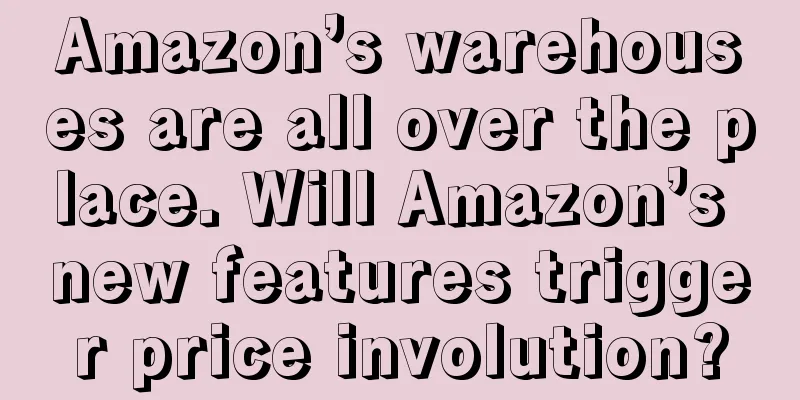Amazon’s warehouses are all over the place. Will Amazon’s new features trigger price involution?

|
As the consumer market fluctuates, despite the pressure of inflation, American consumers are still enthusiastic about spending during festivals such as Halloween. According to a report released by LendingTree, 47% of American consumers plan to make "big purchases", and the average consumer spending during Halloween is expected to reach US$172, higher than in 2023. This should be a good opportunity for sellers, but the actual situation is much more complicated. A large number of sellers' goods cannot be put on the shelves Logistics issues have become a major concern for sellers. Amazon’s warehouses in many locations are overwhelmed by the rush to stock up for the peak season, and warehouse overflows are common. Warehouses such as ABQ2, PSC2, and ABE8 have been constantly canceling contracts, jumping contracts, and being unable to deliver goods, triggering a series of chain reactions. Transportation delays cause goods to be on the road for a long time, inventory squeezes make capital turnover difficult, and out-of-stock situations make sellers miss out on good sales opportunities. Some sellers have reported that the goods cannot be put on the shelves for a long time after they are put into storage. For example, some goods have not been put on the shelves 23 days after being put into storage by BA. In the past six months, the problem of goods being put on the shelves for too long has generally existed. The goods are either in transit or on the way to transit. This situation is even more serious in Amazon's new warehouses in the West Coast, such as PSC2, ABQ2, and MIT2. Sellers face many problems such as difficulty in making appointments, low delivery efficiency, and long transit time. To make matters worse, Amazon continues to charge inventory fees during the period when the goods are reserved and cannot be sold. Amazon's new feature The new features and initiatives of the Amazon platform have also brought new shocks to sellers. The first is the launch and continuous upgrading of the AI search tool Rufus. It provides services in the form of chat questions and answers, and was later launched on the front-end page navigation bar on the computer. The product details page also has its intelligent questions and answers. In mid-September, the US site also tested the introduction of advertising into Rufus. Recently, Rufus has launched a price history query function, which allows consumers to view the pricing trend and lowest price of products in the past 30 days, and receive notifications when the price of items in the shopping cart changes . This seems to be helpful for consumers to obtain price information, but on the other hand, the "Not competively priced" label updated by Amazon's front desk has made sellers miserable. Once the product pricing does not meet the requirements, the purchase column may be hidden, resulting in a large number of sellers losing their shopping carts and a sharp drop in sales of hot-selling products. This series of measures has, to a certain extent, exacerbated the price competition among sellers. For small and medium-sized sellers, the lack of deep supply chain support makes it difficult to be price competitive, and their profit margins are further squeezed. In such a difficult situation, sellers cannot just limit themselves to price competition. Although price is an important factor affecting consumer purchases, it is not the only factor. Sellers should start with product differentiation, build their own competitive barriers, and stand out in the fierce market competition by improving product quality and optimizing services. In short, Amazon sellers in 2024 are facing the dual challenges of logistics difficulties and new platform dynamics. They need to actively find coping strategies to survive and develop in the e-commerce market. |
<<: Amazon listing perfect landing standards
>>: Amazon Advertising: Waterfall Flow Delivery Steps Breakdown
Recommend
What is the French Lengow? French Lengow Review
Lengow is the largest advertising and software com...
Breaking news! The shopping cart acquisition rate of a large number of sellers has plummeted to 40%
On the first day after Prime Day, however, when al...
What is Citilink.ru? Citilink.ru Review
Citilink.ru is a leader in Russia's 3C home ap...
What is KouHi? KouHi Review
Kouhigh was founded in 2018. It is a cross-border ...
From Amazon to multiple platforms, a large number of sellers are continuing to explode!
text Recently, Amazon has continued to ban accoun...
13,000 dryers sold on Amazon and other platforms have been recalled! There is a fire hazard
It is learned that the U.S. Consumer Product Safet...
U.S. retail spending in July exceeded expectations as consumers spent heavily on Prime Day
It is learned that according to foreign media repo...
Get these 10 novel dropshipping products in 2019 to start a new year of wealth
<span data-shimo-docs="[[20,"代发货卖家们看这里!20...
Amazon keyword organic rankings suddenly disappeared in large areas. Is it an algorithm adjustment or a system bug?
Recently, many sellers’ good links have suddenly ...
U.S. online grocery market continues to grow, with sales reaching $7.7 billion in June
Recently, according to foreign media reports, the ...
3 Ways to Play with Amazon's 100% Strike-through List Price
Everyone should know that there are several impor...
What is Noon.com? Noon.com Review
Noon.com is known as the "first e-commerce pl...
What is BlueFocus? BlueFocus Review
BlueFocus is a marketing technology company that f...
What is Freight Forwarder Assistant? Freight Forwarder Assistant Review
Freight Forwarder Assistant is a software speciall...
The US election is in the countdown! Riots are escalating! "Buying sprees" are appearing in many places...
In recent days, news about the " US election ...









